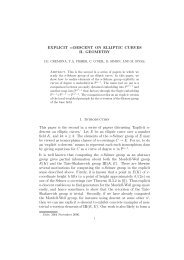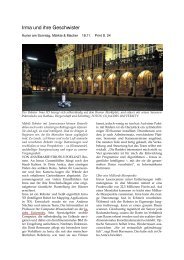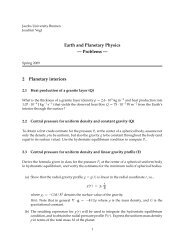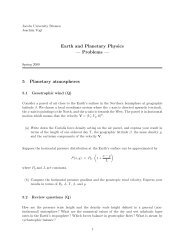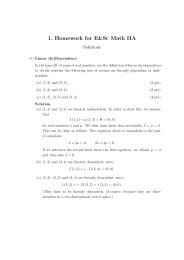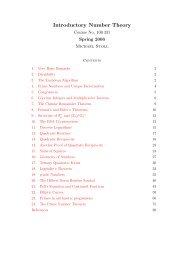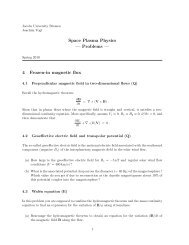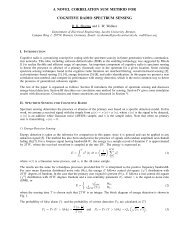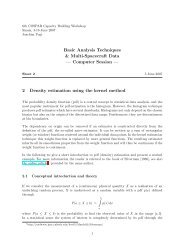Linear Algebra II (pdf, 500 kB)
Linear Algebra II (pdf, 500 kB)
Linear Algebra II (pdf, 500 kB)
You also want an ePaper? Increase the reach of your titles
YUMPU automatically turns print PDFs into web optimized ePapers that Google loves.
30<br />
the standard basis vectors. However, Lemma 8.18 tells us that (for example)<br />
v1 = (1, 1, 0) ⊤ will do. So we make a first change of basis to obtain<br />
A ′ ⎛<br />
1<br />
= ⎝0 1<br />
1<br />
⎞ ⎛<br />
0 1<br />
0⎠<br />
A ⎝1 0<br />
1<br />
⎞ ⎛<br />
0 2<br />
0⎠<br />
= ⎝1 1<br />
0<br />
⎞<br />
2<br />
1⎠<br />
.<br />
0 0 1 0 0 1 2 1 0<br />
Now we have to find a basis of the orthogonal complement L(v1) ⊥ . This can be<br />
done by adding suitable multiples of v1 to the other basis elements, in order to<br />
make the off-diagonal entries in the first row and column of the matrix zero. Here<br />
we have to add −1/2 times the first basis vector to the second, and add −1 times<br />
the first basis vector to the third. This gives<br />
A ′′ ⎛<br />
1 0 0<br />
= ⎝− 1<br />
⎞<br />
1 0⎠<br />
2 A<br />
−1 0 0<br />
′<br />
⎛<br />
1 1 − 2<br />
⎝ −1<br />
⎞ ⎛<br />
2 0 0<br />
0 1 0 ⎠ = ⎝0 −<br />
0 0 1<br />
1<br />
⎞<br />
0 ⎠<br />
2 .<br />
0 0 −2<br />
We are lucky: this matrix is already diagonal. (Otherwise, we would have to<br />
continue in the same way with the 2 × 2 matrix in the lower right.) The total<br />
change of basis is indicated by the product of the two P ’s that we have used:<br />
⎛ ⎞ ⎛<br />
1<br />
1 0 0 1 − 2<br />
P = ⎝1 1 0⎠<br />
⎝<br />
0 0 1<br />
−1<br />
⎞ ⎛<br />
1 1 − 2<br />
0 1 0 ⎠ = ⎝<br />
0 0 1<br />
−1<br />
1 1 2 −1<br />
⎞<br />
⎠<br />
0 0 1<br />
so the desired basis is v1 = (1, 1, 0) ⊤ , v2 = (− 1 1 , 2 2 , 0)⊤ , v3 = (−1, −1, 1) ⊤ .<br />
For algebraically closed fields like C, we get a very nice result.<br />
8.22. Theorem (Classification of Symmetric Bilinear Forms Over C). Let<br />
F be algebraically closed, for example F = C. Then every symmetric matrix<br />
A ∈ Mat(n, F ) is congruent to a matrix<br />
<br />
Ir 0<br />
,<br />
0 0<br />
and the rank 0 ≤ r ≤ n is uniquely determined.<br />
Proof. By Thm. 8.19, A is congruent to a diagonal matrix, and we can assume that<br />
all zero diagonal entries come at the end. Let ajj be a non-zero diagonal entry.<br />
Then we can scale the corresponding basis vector by 1/ √ ajj (which exists in F ,<br />
since F is algebraically closed); in the new matrix we get, this entry is then 1.<br />
The uniqueness statement follows from the fact that n − r is the dimension of the<br />
(left or right) kernel of the associated bilinear form. <br />
If F = R, we have a similar statement. Let us first make a definition.<br />
8.23. Definition. Let V be a real vector space, φ a symmetric bilinear form on V.<br />
Then φ is positive definite if<br />
φ(v, v) > 0 for all v ∈ V \ {0}.<br />
8.24. Remark. A positive definite symmetric bilinear form is non-degenerate: if<br />
v = 0, then φ(v, v) > 0, so = 0, hence v is not in the (left or right) kernel of v.<br />
For example, this implies that the Hilbert matrix from Example 8.13 is invertible.



